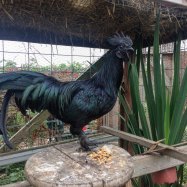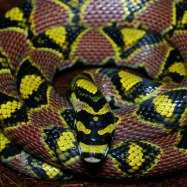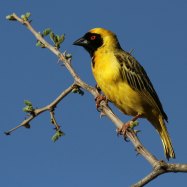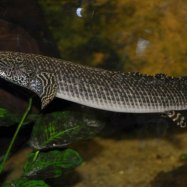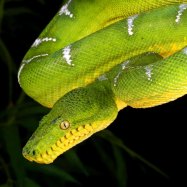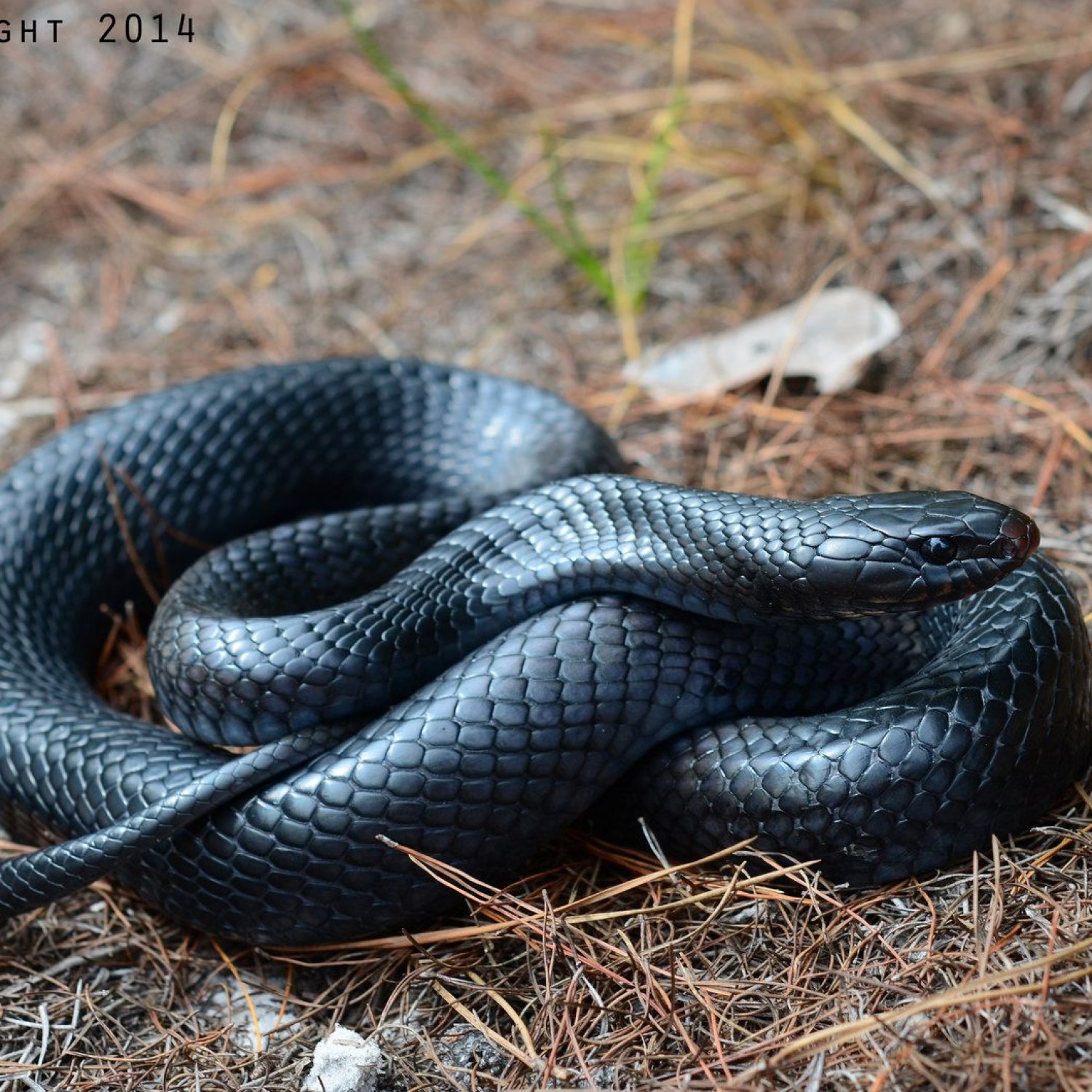
Eastern Indigo Snake
6 - 8 feet
The Eastern Indigo Snake, native to the southeastern United States, is the longest snake in North America with a length of 6 to 8 feet. They are nonvenomous and belong to the Colubridae family. These beautiful and glossy reptiles can be found in Florida, Georgia, South Carolina, and Alabama, making them a must-see for any wildlife enthusiast. #EasternIndigoSnake #FloridaWildlife #Colubridae
Animal Details Summary:
Common Name: Eastern Indigo Snake
Kingdom: Animalia
Habitat: Pine flatwoods, sandhills, and coastal scrub habitats
The Mighty Eastern Indigo Snake: A Ruler of the Southeastern United States
Deep in the heart of the southeastern United States lies a powerful and majestic creature, known to many as the Eastern Indigo Snake. Scientifically known as Drymarchon couperi, this reptile is a sight to behold. With its impressive size, striking coloration, and fierce personality, the Eastern Indigo Snake is truly a ruler of its habitat. Let's take a closer look at what makes this creature so unique and why it deserves our attention Eastern Indigo Snake.A Royal Lineage
The Eastern Indigo Snake belongs to the Animalia kingdom and Chordata phylum, placing it among other vertebrate animals. It is classified under the Reptilia class and Squamata order, making it a proud member of the snake family. However, what sets the Eastern Indigo Snake apart is its family, Colubridae, which includes a vast variety of nonvenomous snakes.Pine Flatwoods, Sandhills, and Coastal Scrub Habitats
Where does this magnificent creature call home? The Eastern Indigo Snake can be found in pine flatwoods, sandhills, and coastal scrub habitats. These areas are typically characterized by sandy soils, scattered pine trees, and low-lying vegetation. The snake prefers to make its home in gopher tortoise burrows, which provide shelter and protection from predators and extreme weather conditions.A Carnivorous Lifestyle
The Eastern Indigo Snake is a carnivore, which means it feeds on other animals to survive. Its diet primarily consists of small mammals, such as mice, rats, and rabbits. It is also known to occasionally prey on other reptiles, including venomous snakes such as rattlesnakes European Starling. This powerful predator is skilled at overpowering its prey, thanks to its muscular body and sharp teeth.A Geographical Icon
Native to the southeastern United States, the Eastern Indigo Snake can be found in several states, including Florida, Georgia, South Carolina, and Alabama. This snake's geographical distribution is limited to these areas, making it a true gem of the southeastern region. Its range extends from southern Georgia to central Florida, with some populations scattered along the Gulf Coast.The American Pride
The Eastern Indigo Snake is a country of origin is the United States, and it has become a symbol of American pride. This reptile is celebrated by Americans and is even recognized as the state reptile of Florida. Its presence is essential to the ecosystem, and its conservation efforts reflect the country's dedication to preserving its natural heritage.A Polished Appearance
One cannot help but be in awe at the Eastern Indigo Snake's remarkable appearance. Its body is covered in a shiny black to bluish-black color, giving it a glossy finish. But that's not all – some individuals may have a reddish or olive tint, adding an extra layer of sophistication to its exterior. Its impressive coloration has earned it the nickname "glossy black king snake."Streamlined to Perfection
The Eastern Indigo Snake's body shape is another standout feature. With a length of 6 to 8 feet, this snake is one of the longest nonvenomous snakes in North America. Its large and streamlined body allows it to move quickly and effortlessly through its habitat. Its tapered head, smooth scales, and strong muscles make it a formidable predator that commands respect.A Relentless Hunter
The Eastern Indigo Snake's abilities go beyond its striking appearance. As a top predator, it plays an essential role in balancing the ecosystem. Its carnivorous diet helps to keep the population of smaller rodents and reptiles in check, preventing overpopulation and preserving the biodiversity of its habitat. Its extraordinary hunting skills make it a force to be reckoned with in the animal kingdom.A Future at Risk
While the Eastern Indigo Snake is a powerful and resilient creature, it is currently facing several threats that put its future at risk. Its habitat is under constant threat of destruction due to urbanization, agriculture, and human development. Illegal poaching and pet trade also pose a significant risk to its survival. Combined with its slow reproductive rate, these factors make the Eastern Indigo Snake a species of conservation concern.A Race Against Time
Thankfully, organizations and government agencies are working tirelessly to protect this magnificent creature and its habitat. Conservation efforts include habitat restoration, captive breeding programs, and education initiatives to raise awareness about the snake's importance. In recent years, the Eastern Indigo Snake's conservation status has shown improvement, giving hope to its survival and future generations to come.The Importance of Coexistence
The Eastern Indigo Snake's story is a testament to the delicate balance of nature and the importance of coexistence. As humans, it is our responsibility to protect and preserve the natural world and the creatures that call it home. A world without the Eastern Indigo Snake would not only be a loss to the southeastern United States, but it would also be a loss to the world.A True American Icon
In conclusion, the Eastern Indigo Snake is a truly remarkable creature that commands attention and admiration. Its impressive size, striking coloration, and powerful presence make it a ruler of its habitat. For Americans, it serves as a symbol of pride and a reminder of the importance of preserving our natural heritage. Let us continue to work towards the conservation and protection of this incredible species so that future generations can continue to admire the Eastern Indigo Snake for years to come.

Eastern Indigo Snake
Animal Details Eastern Indigo Snake - Scientific Name: Drymarchon couperi
- Category: Animals E
- Scientific Name: Drymarchon couperi
- Common Name: Eastern Indigo Snake
- Kingdom: Animalia
- Phylum: Chordata
- Class: Reptilia
- Order: Squamata
- Family: Colubridae
- Habitat: Pine flatwoods, sandhills, and coastal scrub habitats
- Feeding Method: Carnivorous
- Geographical Distribution: Southeastern United States
- Country of Origin: United States
- Location: Florida, Georgia, South Carolina, Alabama
- Animal Coloration: Shiny black to bluish-black; some individuals have a reddish or olive tint
- Body Shape: Large and streamlined with a glossy appearance
- Length: 6 - 8 feet
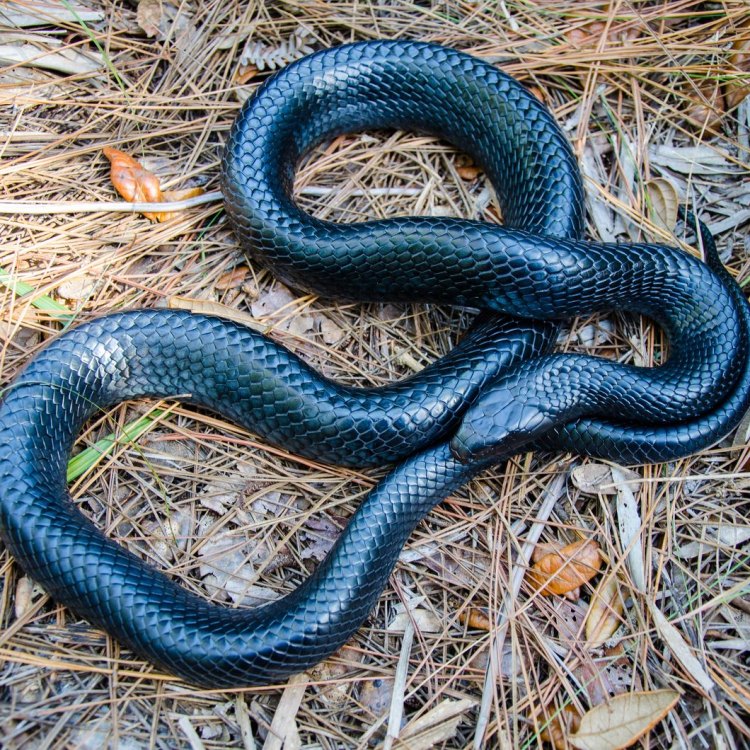
Eastern Indigo Snake
- Adult Size: 6 - 8 feet
- Average Lifespan: 20 - 30 years
- Reproduction: Oviparous
- Reproductive Behavior: Mating occurs in the spring; females lay 4-12 eggs in burrows or decaying vegetation
- Sound or Call: Produces a low hissing sound when threatened
- Migration Pattern: Non-migratory
- Social Groups: Solitary
- Behavior: Nocturnal, shy, and non-aggressive
- Threats: Habitat loss, road mortality, persecution by humans, and collection for the pet trade
- Conservation Status: Endangered
- Impact on Ecosystem: Important predators of small mammals, birds, and reptiles; help control populations of prey species
- Human Use: Protected by state and federal laws; used in educational programs to raise awareness about conservation
- Distinctive Features: Shiny black coloration, smooth scales, prominent chin shield, and large size
- Interesting Facts: Eastern Indigo Snakes are the longest native snake species in the United States. They are known to eat venomous snakes, including rattlesnakes and copperheads.
- Predator: Humans, birds of prey, alligators
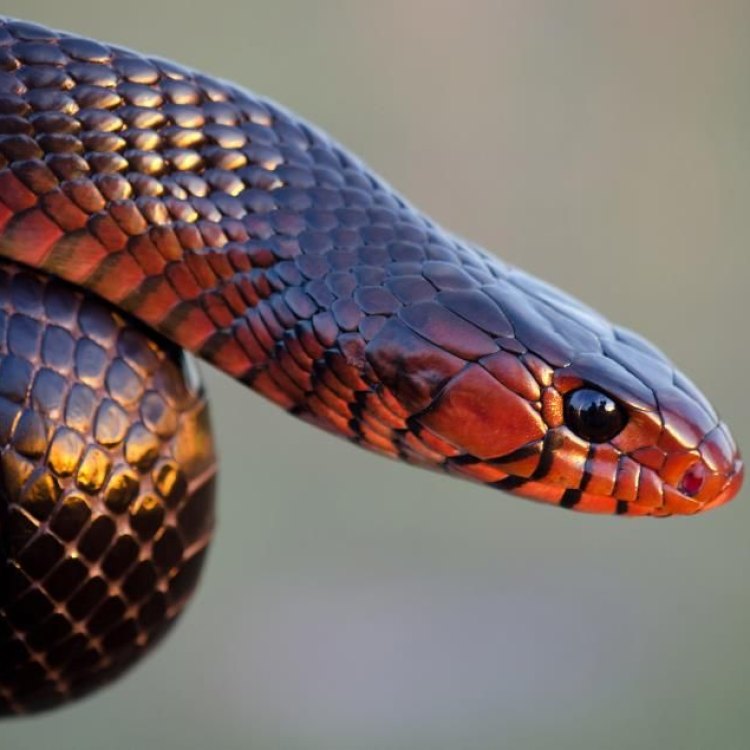
Drymarchon couperi
The Mighty Eastern Indigo Snake: A Fascinating and Endangered Species
In the vast array of wildlife that inhabit the eastern region of the United States, the Eastern Indigo Snake stands out as a unique and intriguing species. From its impressive size to its important role in the ecosystem, these creatures have captivated the attention of researchers and nature enthusiasts alike. However, despite their significance, these snakes are facing serious threats that have led to their endangered status. In this article, we will delve into the lives and remarkable features of the Eastern Indigo Snake, while also shedding light on the conservation efforts being made to protect this species PeaceOfAnimals.Com.The Eastern Indigo Snake (Drymarchon couperi) is a non-venomous colubrid snake native to the southeastern United States. As the largest native snake species in the country, they can grow up to 6-8 feet in length, with rare individuals reaching up to 9 feet. Their size, combined with their glossy black coloration, makes them an impressive sight in the wild. In fact, they are often referred to as the "blue indigo" due to their iridescent shine in the sunlight.
One of the most distinctive features of Eastern Indigo Snakes is their smooth scales. Unlike other snakes, their scales have a unique sheen to them, giving them a sleek and impressive appearance. They also have a prominent chin shield, which is believed to aid in burrowing and foraging for food. These snakes are also known for their large size, making them the largest snake species in their geographic range.
On average, Eastern Indigo Snakes have a lifespan of 20-30 years, with some individuals living up to 40 years in captivity Eastern Dobsonfly. These snakes are oviparous, meaning they lay eggs rather than giving birth to live young. The breeding season for these snakes occurs in the spring, with mating taking place between April and May. Females will lay 4-12 eggs in burrows or decaying vegetation, and they will fiercely guard their eggs until they hatch.
Reproduction is not the only time Eastern Indigo Snakes display interesting behaviors. Despite their size and intimidating appearance, these snakes are typically shy and non-aggressive. They are nocturnal creatures, preferring to hunt and forage under the cover of darkness. When threatened, they will produce a low hissing sound, but they rarely display aggression towards humans.
Another fascinating behavior of these snakes is their diet. As top predators in their environment, Eastern Indigo Snakes play a vital role in controlling prey species. They are opportunistic feeders, meaning they will eat a variety of prey, including small mammals, birds, and other reptiles. However, one of their most interesting prey items is venomous snakes, such as rattlesnakes and copperheads. This unique behavior has earned them the nickname "king of snakes."
Unfortunately, these remarkable creatures are facing many threats that have led to their endangered status. The primary threat to Eastern Indigo Snakes is habitat loss. As urbanization and development continue to expand, their natural habitat is being destroyed, making it difficult for them to find suitable food and shelter. Road mortality is also a significant threat, as these snakes are often hit by cars while crossing roads. Persecution by humans is also a concern, as they are often misunderstood and feared, leading to intentional killings.
Another major concern for the conservation of Eastern Indigo Snakes is their collection for the pet trade. Due to their large size and impressive appearance, these snakes are highly sought after in the exotic pet market. However, this practice is not only harmful to the individual snakes but also contributes to the decline of the species in the wild.
To combat these threats, Eastern Indigo Snakes are protected by state and federal laws, making it illegal to harm, kill, or collect them without a special permit. Conservation efforts, such as habitat restoration and captive breeding programs, are also in place to help increase their population in the wild. Additionally, these snakes are used in educational programs to raise awareness about their importance and the need for their protection.
The Eastern Indigo Snake's unique features and behaviors have also made them popular among nature enthusiasts and researchers. Their role as an important predator in the ecosystem has led to extensive research and conservation efforts to protect them. However, these efforts are not only for the benefit of these snakes, but also for the overall health of the environment.
Eastern Indigo Snakes are found in a variety of habitats, including pine flatwoods, scrub, and hardwood hammocks. They are non-migratory, meaning they do not travel long distances, and are usually solitary creatures. However, during the breeding season, they may interact with other snakes to mate. This behavior makes them an essential part of their ecosystem, as they help control the population of prey species, keeping the ecological balance in check.
However, Eastern Indigo Snakes also have their own predators to worry about. Human activities, such as habitat destruction and persecution, have contributed to the decline of this species. Additionally, birds of prey and alligators are known to prey on these snakes. However, their biggest predator is humans, and it is up to us to ensure their survival.
In conclusion, the Eastern Indigo Snake is a fascinating and unique species that is facing serious threats to its survival. Their impressive size, behavior, and important role in the ecosystem make them a truly remarkable creature. However, it is crucial that we take active steps to protect these snakes and their natural habitat. By raising awareness and supporting conservation efforts, we can ensure that future generations get to witness the beauty and significance of the Eastern Indigo Snake in the wild.
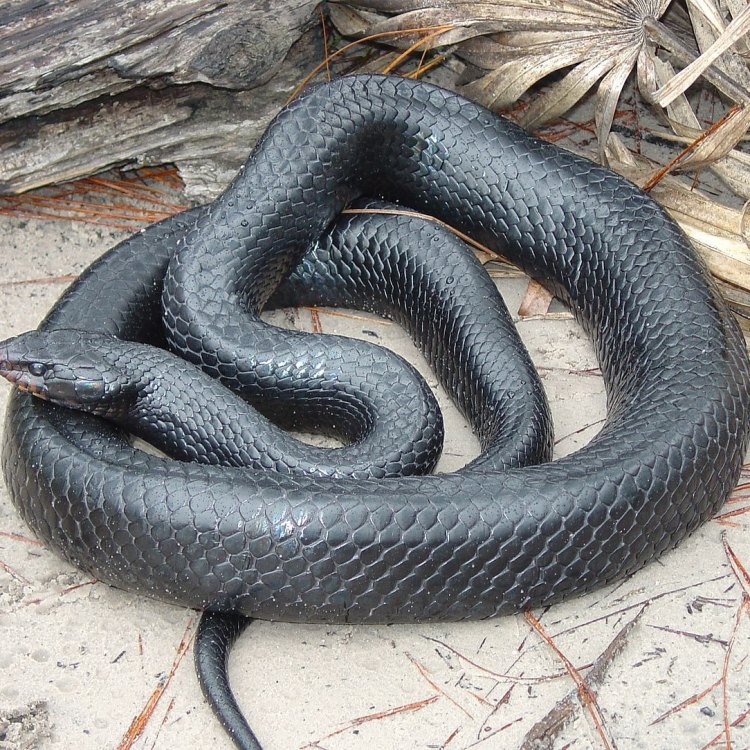
The Mighty Eastern Indigo Snake: A Ruler of the Southeastern United States
Disclaimer: The content provided is for informational purposes only. We cannot guarantee the accuracy of the information on this page 100%. All information provided here may change without prior notice.







